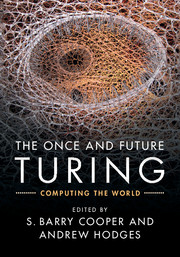Book contents
- Frontmatter
- Contents
- Contributors
- Preface
- Introduction
- Part One Inside Our Computable World, and the Mathematics of Universality
- Part Two The Computation of Processes, and Not Computing the Brain
- Part Three The Reverse Engineering Road to Computing Life
- 9 Turing's Theory of Developmental Pattern Formation
- 10 Walking the Tightrope: The Dilemma of Hierarchical Instabilities in Turing's Morphogenesis
- Part Four Biology, Mind, and the Outer Reaches of Quantum Computation
- Part Five Oracles, Infinitary Computation, and the Physics of the Mind
- Afterword
- References
10 - Walking the Tightrope: The Dilemma of Hierarchical Instabilities in Turing's Morphogenesis
from Part Three - The Reverse Engineering Road to Computing Life
Published online by Cambridge University Press: 05 March 2016
- Frontmatter
- Contents
- Contributors
- Preface
- Introduction
- Part One Inside Our Computable World, and the Mathematics of Universality
- Part Two The Computation of Processes, and Not Computing the Brain
- Part Three The Reverse Engineering Road to Computing Life
- 9 Turing's Theory of Developmental Pattern Formation
- 10 Walking the Tightrope: The Dilemma of Hierarchical Instabilities in Turing's Morphogenesis
- Part Four Biology, Mind, and the Outer Reaches of Quantum Computation
- Part Five Oracles, Infinitary Computation, and the Physics of the Mind
- Afterword
- References
Summary
Dedicated to Bashir Ahmad and a bright future for physics in his Afghanistan.
Ever since we understood that living organisms are made of fundamentally the same stuff as the rest of the universe, we have been puzzling about what makes life different, and how that difference arose. Alan Turing made a major contribution in putting forth a model for morphogenesis that attempts to bridge the gap between the molecules we are made of and how we look. This is a huge gap to span in trying to solve the problem of how an embryo builds itself. People are about 1.5m = 1.5×109nm (nanometers) tall and the typical protein molecule is about 30 nm wide, a ratio of 50 000 000 = 5 × 107 to 1. That protein might contain 1000 amino acids and, if we take into account the relative volumes, not just length, say 70 liters for an adult human and 0.15nm3 for an amino acid (Sühnel and Hühne, 2005), this raises the ratio to 5×1026 to 1.
When we build a bridge, unless it's over a small ditch, we use many parts and assemble them in sections called spans (Figure 10.1). In biology this has come to be known as ‘modularity’, and the grand search has been on to discover just what the modules of life are (von Dassow and Munro, 1999; Gilbert and Bolker, 2001; Redies and Puelles, 2001; Newman and Bhat, 2009; Peter and Davidson, 2009; Christensen et al., 2010). At first it was thought that cells represented modules. The ‘cell theory’ was resisted by a minority of 19th century biologists, who thought that the basic module was the whole organism, not the cell. Certain observations support this ‘organismal’ theory. First, single cell organisms, such as Parameciumand diatoms (Figure 10.2), can have quite complex morphologies; see Gordon (2010); Tiffany et al. (2010); Gordon and Tiffany (2011). Second, some green algae have many nuclei that move in cytoplasmic streaming, unhindered by cell boundaries, yet “… exhibit morphological differentiation into structures that resemble the roots, stems, and leaves of land plants and even have similar functions” (Chisholm et al., 1996); see Cocquyt et al., 2010.
- Type
- Chapter
- Information
- The Once and Future TuringComputing the World, pp. 144 - 159Publisher: Cambridge University PressPrint publication year: 2016
References
- 3
- Cited by

